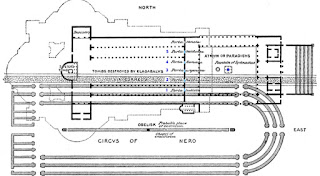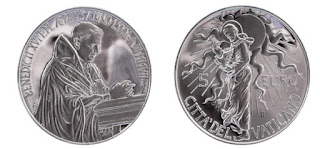Vatican City, officially the Vatican City State (Italian: Stato della Citta del Vaticano), is an independent city-state and enclave located within Rome, Italy. The Vatican City State, also known simply as Vatican, became independent from Italy with the Lateran Treaty (1929), and it is a distinct territory under full ownership, exclusive dominion and sovereign authority and jurisdiction of the Holy See, itself a sovereign entity of international law, which maintains the city state's temporal, diplomatic and spiritual independence.
Vatican City, 5 Lire, Pivs XI, Coin
With an area of 49 hectares (121 acres) and a population of about 825 (as of 2019, includes 453 residents and 372 residing elsewhere), it is the smallest country in the world by both area and population.
As governed by the Holy See, the Vatican City State is an ecclesiastical or sacerdotal-monarchial state ruled by the Pope who is the bishop of Rome and head of the Catholic Church. The name Vatican City was first used in the Lateran Treaty, signed on 11 February 1929, which established the modern city-state named after Vatican Hill, the geographical location of the state. ''Vatican'' is derived from the name of an Etruscan settlement, Vatica or Vaticum located in what the Romans called Ager Vaticanus. The Latin name is Status Civitatis Vaticanae, and is used in official documents by the Holy See, the Church and the Pope.
Flag
Coat of Arms
The name ''Vatican'' was in use in the time of the Roman Republic (509 BC-27 BC) for a marshy area on the west bank of Tiber across the city of Rome, between the Janiculum, the Vatican Hill and Monte Mario, down to the Aventine Hill, up to the confluence of the Cremera creek.
Under the Roman Empire, many villas were constructed, after Agrippina the Elder (14 BC-33 AD). Her son, Emperor Caligula built in her gardens a circus for charioteers (AD 40), that was later completed by Nero, usually called, the Circus of Nero. During the reign of Emperor Constantine I, (272-337 AD), construction of the Old St Peter's Basilica begun over the historical site of the Circus of Nero, over what was believed to be the tomb of Saint Peter. It took 40 years to complete.
Representation of the relative locations of the circus and the medieval and current Basilicas of St Peter
However, in 846 AD, Saracens (a term used by Christian writers in Europe in the Middle Ages to refer to Muslims of Arab, Turkish and Persian origin), sacked and damaged the basilica as also destroyed Saint Peter's tomb and pillaged the holy shrine.
By the 15th century, the Church was falling to ruin. The Saint Peter's Basilica, a church, initially planned by Pope Nicholas V and then Pope Julius II to replace the aging Old St Peter's Basilica began in 1506 AD and was completed in 1626 AD.
Main façade and dome of St Peter's Basilica seen from St Peter's Square
St Peter's Square, the Basilica and Obelisk, from Piazza Pio XII
Popes gradually came to have a secular role as governors of regions near Rome. They ruled the Papal States (officially the State of the Church), which covered a large portion of the Italian peninsula, for more than a thousand years until the mid 19th century, when all these territories were seized by the newly created Kingdom of Italy. In 1870, the Pope's holdings were left in an uncertain situation when Rome itself was annexed. Between 1861 and 1929, the status of the Pope was referred to as the ''Roman Question''.
The Italian peninsula in 1796 AD. The Papal States in central Italy are coloured purple
Italy made no attempts to interfere with the Holy See, however, church property was confiscated in many places. The Quirinal Palace was confiscated and became the Royal Palace. The Popes did not recognize the Italian king's right to rule in Rome, and they refused to leave the Vatican compound until the dispute was resolved in 1929. The Lateran Treaty signed between the Holy See and the Kingdom of Italy, established the independent state of Vatican City and reaffirmed the special status of Catholic Christianity in Italy.
The Ingresso di SantÁnna, an entrance to Vatican City from Italy
During World War II, both the German troops and the Allies respected Vatican City as neutral territory. The Pontifical Swiss Guard, or Swiss Guard, is a minor armed force and honour guard unit maintained by the Holy See that protects the Apostolic Palace and the Pope within the territory of Vatican City since 1506 AD.
Group of Pontifical Swiss Guard inside St Peter's Basilica
In 1984, a new concordat between the Holy See and Italy modified certain provisions of the earlier treaty, including the position of Catholic Christianity as the Italian state religion, a position given to it by the statute of the Kingdom of Sardinia of 1848.
Vatican City issues its own coins and stamps. It has used the euro as its currency since January 1999, owing to a special agreement with the European Union. Euro coins and notes were introduced in January 2002. The Vatican does not issue euro banknotes. Because of their rarity, Vatican Euro coins are highly sought by collectors. Until the adoption of Euro, Vatican coinage and stamps were denominated in their own Vatican lira currency, which was on par with the Italian lira.
The Institute for Works of Religion, also known as the Vatican Bank, is a financial agency situated in the Vatican that conducts worldwide financial activities. It has multilingual ATM's with instructions in Latin, possibly the only ATM in the world with this feature.
Coins of Papal States and Vatican City
Papal States, 1 Grosso, John XXII, 1317-1321 AD, silver, weight 3.8 gm, Obverse: John seated facing, holding cross and raising right hand in benediction, on throne composed of two lions, let'tering IOhÉS: PAPA: XXII COmES: VEnAlnl, Reverse: Cross fleurée with lettering around
Vatican City, 10 Centesimi, Pivs XI, 1929-1938, bronze, weight 5.5 gm, Obverse: Crowned coat of arms divides date, name of pope, translates to Pius XI Pope Greatest Year Ten (of his reign), Reverse: St Peter bust right, value, translates to State of Vatican City.
Vatican City, 1 Lira, Loannes XXIII, John XXIII, 1959-1962, aluminum, weight 0.6 gm, Obverse: Emblem, Crossed keys, Reverse: Crouching figure



























No comments:
Post a Comment
Any inputs or feedback is welcome!